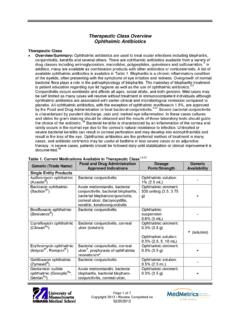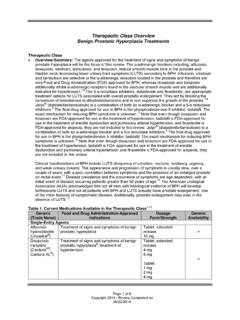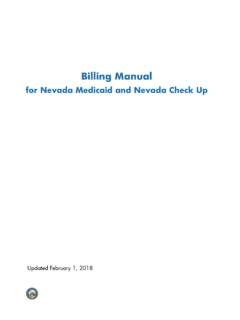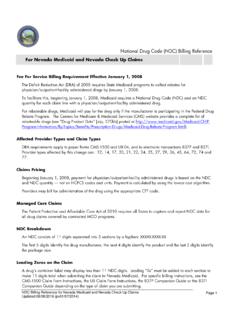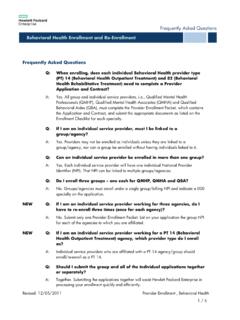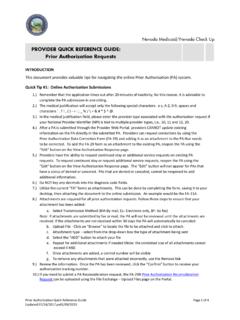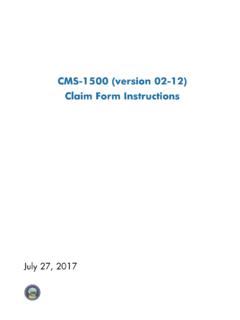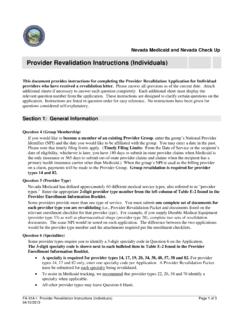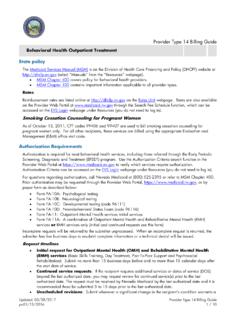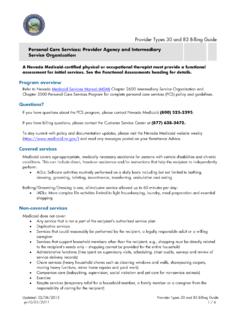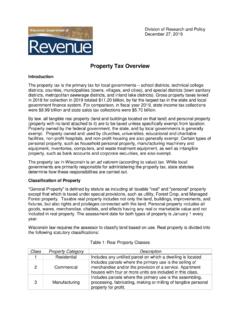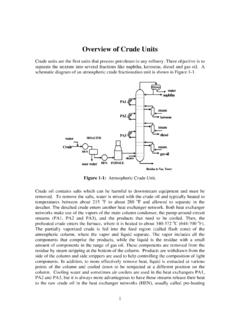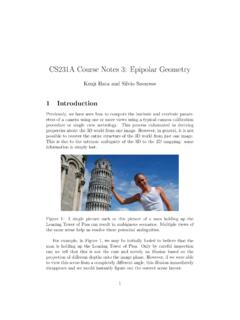Transcription of Therapeutic Class Overview Nonsteroidal Anti-Inflammatory ...
1 Page 1 of 7 Copyright 2016 Review Completed on 01/25/2016 Therapeutic Class Overview Nonsteroidal Anti-Inflammatory Drugs (NSAIDs) Therapeutic Class Overview /Summary: This review encompasses the single-entity oral and injectable Nonsteroidal Anti-Inflammatory drugs (NSAIDs).1-37 NSAIDs are among the most commonly prescribed drugs worldwide to treat common pain and inflammatory Some of the conditions NSAIDS have been Food and Drug Administration (FDA)-approved to treat include acute pain and inflammation, osteoarthritis (OA), rheumatoid arthritis (RA), ankylosing spondylitis (AS), painful shoulder (bursitis and/or tendonitis), acute gouty arthritis, and postoperative pain.
2 Additionally several agents are indicated for the treatment of primary dysmenorrhea, clinically significant patent ductus arterioles, or fever reduction. Each year, approximately 60 million NSAID prescriptions are written, with the number of prescriptions for older patients approximately high er than that for younger patients. NSAIDs have been prescribed for decades and a number are available generically and/or over-the- Salicylates, over-the- counter formulations of ibuprofen and naproxen, any topical and ophthalmic preparations of NSAIDs or combination products will not be included in this review.
3 A list of medications reviewed is summarized in Table 1 and includes various salt formulations for the NSAIDs. The primary mechanism of action of all NSAIDs is through the inhibition of cyclooxygenase (COX), resulting in impaired transformation of arachidonic acid to prostaglandins, prostacyclin, and The COX enzyme can be subdivided into related isoforms, including COX-1 and COX-2; however, important differences in the regulation and expression of these two enzymes in various tissues exist which are relevant to the mechanism of action of NSAIDs and their associated adverse effect profile.
4 Specifically, the COX-2 enzyme is typically undetectable in most tissue except during states of inflammation; therefore, the Anti-Inflammatory properties of NSAIDs are associated with the inhibition of COX In contrast, COX-1 is expressed variably in most tissues and regulates normal cell processes including gastric cytoprotection, vascular homeostasis, platelet aggregation and kidney function. The inhibition of COX-1 by NSAIDs is thought to be associated with the well-established gastrointestinal adverse reaction profile of these agents, which includes dyspepsia, peptic ulcer disease and All NSAID-containing agents are associated with a Black Box Warning regarding the increased risk of serious gastrointestinal adverse reactions including bleeding, ulceration and perforation of the stomach and intestines, which can be Additionally, ketorolac tromethamine, a potent NSAID, is also contraindicated in renal impairment, patients at risk of bleeding ( , before surgery)
5 , and during labor, delivery, breast-feeding and coadministration with other Due to these risks, ketorolac should only be administered for acute pain ( 5 days).15-17 NSAIDs have traditionally been grouped by their chemical characteristics. Currently available products have been derived from acetic acid, anthranilic acid, enolic acid, or propionic acid. However, with the development of products selective to COX-2, classification has begun to shift towards selectivity, rather than chemical There is only one selective COX-2 inhibitor currently available, celecoxib (Celebrex ). In addition, recent evidence suggests that some of the older NSAIDs such as diclofenac and meloxicam show some selectivity towards the COX-2 Due to the variability in NSAID half-life (t1/2), a classification system has also been developed to group NSAIDs by half-life.
6 Some NSAIDs such as ibuprofen and diclofenac are eliminated rapidly (t1/2 of one to four hours), while other agents have a much greater half-life. Agents with t1/2 greater than 10 hours include: celecoxib, naproxen, meloxicam, nabumetone, oxaprozin and piroxicam. Piroxicam has an estimated t1/2 of 50 Agents with longer half-lives are generally given once per day. Therapeutic Class Overview : n onsteroidal anti -i nflammatory drugs (NSAIDs) Page 2 of 7 Copyright 201 6 Review Completed on 01/25/2016 Table 1. Current Medications Available in the Therapeutic Class1-34 Generic (Trade Name) Food and Drug Administration-Approved Indications Dosage Form/Strength Generic Availability Acetic Acid Derivatives Diclofenac (Zorvolex ) Mild to Moderate Pain, Osteoarthritis Capsule: 18 mg 35 mg - Diclofenac potassium (Cataflam *, Zipsor ) Acute Pain, Mild to Moderate Pain, Primary Dysmenorrhea, Osteoarthritis, Rheumatoid Arthritis Capsule, liquid filled (Zipsor ): 25 mg Tablet, sugar coated (Cataflam ).
7 50 mg a Diclofenac sodium* (Dyloject , Voltaren XR *) Acute Pain, Ankylosing Spondylitis, Osteoarthritis, Rheumatoid Arthritis Tablet, DR: 25 mg 50 mg 75 mg Tablet, film coated ER (Voltaren XR ): 100 mg Solution, injection (Dyloject ) mg/mL a Etodolac* Acute Pain, Osteoarthritis, Rheumatoid Arthritis, Juvenile Rheumatoid Arthritis (age six and older) Capsule: 200 mg 300 mg Tablet, ER: 400 mg 500 mg 600 mg Tablet, film coated: 400 mg 500 mg a Indomethacin* (Indocin , Tivorbex ) Acute Pain, Acute Gouty Arthritis, Acute Shoulder Pain, Ankylosing Spondylitis, Rheumatoid Arthritis, Osteoarthritis Capsule: 20 mg (Tivorbex ) 25 mg 40 mg (Tivorbex ) 50 mg Capsule, ER: 75 mg Suppository: 50 mg (Indocin ) Suspension, oral: 25 mg/5 mL (Indocin ) a Indomethacin sodium Closure of Patent Ductus Arteriosus (Neonatal patients) Solution, lyophilized powder for injection: 1 mg/vial - Therapeutic Class Overview .
8 N onsteroidal anti -i nflammatory drugs (NSAIDs) Page 3 of 7 Copyright 201 6 Review Completed on 01/25/2016 Generic (Trade Name) Food and Drug Administration-Approved Indications Dosage Form/Strength Generic Availability Ketorolac tromethamine* (Sprix ) Moderate to severe acute pain: Nasal Spray, metered: mg/spray Solution, injection (vial): 15 mg/mL 30 mg/mL 60 mg/2 mL 300 mg/10 mL Tablet, film coated: 10 mg a Nabumetone* Osteoarthritis, Rheumatoid Arthritis Tablet: 500 mg 750 mg a Sulindac* Acute Gouty Arthritis, Acute Shoulder Pain, Ankylosing Spondylitis, Osteoarthritis, Rheumatoid Arthritis Tablet: 150 mg 200 mg a Tolmetin sodium* Osteoarthritis, Rheumatoid Arthritis, Juvenile Rheumatoid Arthritis (age 2 or older) Capsule: 400 mg Tablet: 200 mg 600 mg a Anthranilic Acid (Fenamate) Derivatives Meclofenamate sodium Fever Reduction, Mild to moderate pain, Primary dysmenorrhea, Rheumatoid arthritis, osteoarthritis Capsule: 50 mg 100 mg - Mefenamic acid (Ponstel *) Mild to moderate pain, Primary dysmenorrhea Capsule.
9 250 mg a Enolic Acid Derivatives Meloxicam (Mobic *, Vivlodex ) Osteoarthritis, Rheumatoid Arthritis, Juvenile Rheumatoid Arthritis (age 2 and older) Capsule (Vivlodex ): 5 mg 10 mg Suspension, oral (Mobic ): mg/5 mL Tablet (Mobic ): mg 15 mg a Piroxicam (Feldene *) Osteoarthritis, Rheumatoid Arthritis Capsule: 10 mg 20 mg a Propionic Acid Derivatives Fenoprofen calcium* (Nalfon *) Mild to Moderate Pain, Osteoarthritis, Rheumatoid Arthritis Capsule: 200 mg 400 mg Tablet, film coated: a Therapeutic Class Overview : n onsteroidal anti -i nflammatory drugs (NSAIDs) Page 4 of 7 Copyright 201 6 Review Completed on 01/25/2016 Generic (Trade Name) Food and Drug Administration-Approved Indications Dosage Form/Strength Generic Availability 600 mg Flurbiprofen* Osteoarthritis, Rheumatoid Arthritis Tablet: 50 mg 100 mg a Ibuprofen* (Caldolor ) Fever Reduction, Mild to Moderate Pain, Moderate to Severe Pain, Osteoarthritis, Rheumatoid Arthritis, Primary Dysmenorrhea: Injection (Caldolor ): 400 mg/mL 800 mg/mL Tablet, film coated.
10 400 mg 600 mg 800 mg a Ibuprofen Lysine (Neoprofen ) Closure of Patent Ductus Arteriosus (Neonatal patients) Solution, injection: 10 mg/mL - Ketoprofen* Acute Pain, Primary Dysmenorrhea, Osteoarthritis, Rheumatoid Arthritis Capsule: 50 mg 75 mg a Naproxen (EC -Naprosyn *, Naprosyn *) Ankylosing Spondylitis, Osteoarthritis, Rheumatoid Arthritis, Acute Gouty Arthritis, Juvenile rheumatoid arthritis (5 years of age and older) DR Tablet (EC-Naprosyn ): 375 mg Suspension, oral: 125 mg/5 mL Tablet (Naprosyn ): 250 mg 375 mg 500 mg a Naproxen sodium (Anaprox *, Anaprox DS *, Naprelan *) Ankylosing Spondylitis, Osteoarthritis, Rheumatoid Arthritis, Acute Gouty Arthritis, Acute Pain, Acute Shoulder Pain, Primary Dysmenorrhea Tablet: 275 mg (Anaprox ) 550 mg (Anaprox DS ) ER tablet: 375 mg 500 mg 750 mg a Oxaprozin (Daypro *) Osteoarthritis, Rheumatoid arthritis, Juvenile Rheumatoid Arthritis (6 years of age and older) Tablet: 600 mg a Selective COX-2 Inhibitors Celecoxib (Celebrex *) Acute Pain, Primary Dysmenorrhea, Juvenile Rheumatoid Arthritis (2 years of age and older) Capsule.
